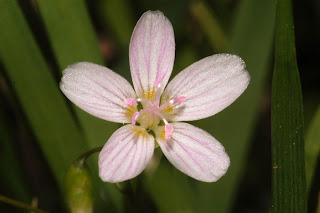 This is Claytonia, commonly called "Spring Beauty" and that it is! The ditches over in Wilderness are white with these delicate little flowers that range in color from white to pink with pink veins and stamens. The macro lens reveals the exquisite detail of the little flowers that grow from a small underground tuber similiar to a small sweet potato that has a nut like flavor. Named for Va. botanist John Clayton.
This is Claytonia, commonly called "Spring Beauty" and that it is! The ditches over in Wilderness are white with these delicate little flowers that range in color from white to pink with pink veins and stamens. The macro lens reveals the exquisite detail of the little flowers that grow from a small underground tuber similiar to a small sweet potato that has a nut like flavor. Named for Va. botanist John Clayton.







